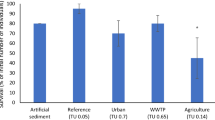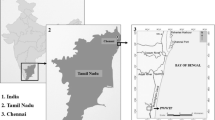Abstract
A sediment toxicity test using reproduction in the tubificid oligochaete Tubifex tubifex was tested in 11 geographic locations in the Laurentian Great Lakes where sediments have previously been documented as being contaminated. Samples were taken from both potentially contaminated and “clean” sites in each of the 11 areas. Using test endpoints such as survival and growth, results from 72 samples were classified using cluster and ordination techniques. Six response groups were identified and four groups of toxic sites determined. Toxic effects ranged from mortality of adult worms to reduced reproduction. Using correlation and discriminant analysis there was good evidence that high concentrations of metals such as copper and lead were responsible for the observed effects at some sites.
Similar content being viewed by others
References
Belbin, L. In press. SSH: Semi-strong hybrid scaling. Classification Society.
Duncan, G. A. & G. G. LaHaie, 1979. Size analysis procedures used in the sedimentology laboratory. NWRI, CCIW, Hydraulics Div. Manual. September, 1979, *pp.
Giesy, J. P. & R. A. Hoke, 1989. Freshwater sediment toxicity bioassessment: rationale for test species selection and test design. J. Great Lakes Res. 15: 539–569.
International Joint Commission, 1987. Guidance on characterization of toxic substances problems in Areas of Concern in the Great Lakes basin. Report to the Great Lakes Water Quality Board. Windsor, Ontario, 179 pp.
International Joint Commission, 1988. Procedures for the assessment of contaminated sediment problems in the Great Lakes. Report to the Great Lakes Water Quality Board. Windsor, Ontario, 140 pp.
Long, E. R. & P. M. Chapman, 1985. A sediment quality triad: measures of sediment contamination, toxicity and infaunal community composition in Puget Sound. Mar. Poll. Bull. 16: 405–415.
Mudroch, A., 1985. Geochemistry of the Detroit River sediments. J. Great Lakes Res. 11: 193–200.
Reynoldson, T. B., A. Mudroch & C. J. Edwards, 1988. An overview of contaminated sediments in the Great Lakes with special reference to the international workshop held at Aberystwyth, Wales, U.K. Report to the Great Lakes Science Advisory Board. Windsor, Ontario, 41 pp.
Reynoldson, T. B., S. P. Thompson & J. L. Bamsey, 1991. A sediment bioassay using the tubificid oligochaete worm Tubifex tubifex. Env. Toxicol. Chem. 10: 1061–1072.
Wilkinson, L., 1990. SYSTAT: The system for statistics. Evanston, Illinois SYSTAT, Inc..
Zarull, M. A. & T. B. Reynoldson, 1992. A management strategy for contaminated sediment: Assessment and remediation. Water Poll. Res. J. Canada. 27: 871–882.
Author information
Authors and Affiliations
Rights and permissions
About this article
Cite this article
Reynoldson, T.B. A field test of a sediment bioassay with the oligochaete worm Tubifex tubifex (Müller, 1774). Hydrobiologia 278, 223–230 (1994). https://doi.org/10.1007/BF00142330
Issue Date:
DOI: https://doi.org/10.1007/BF00142330




